Keywords
|
| Energy, Modern Electronic System, Pic-Microcontroller, consumption of energy |
INTRODUCTION
|
| The economic development of a modern society is strongly dependent on energy. Production & supply of goods and energy consumption has strong effect on the environment at local and global level. It demands a good balance between the use of energy for development of social welfare and the preservation of environment, as overuse may lead to negative environmental impacts. So management of energy is essential at this point of time, since the conventional resource will surely be exhausted within a few years. ItâÃâ¬ÃŸs an endeavour to manage the use of electrical energy through the design of advanced system with a view to reduce the consumption of energy and subsequently to reduce the bill of electricity. At the same time the saving of conventional fuel will lead to extension of use of energy for longer period and hence the conservation of energy. |
| The paper [1] deals with energy audit and comparison with the Energy Efficiency Measure. Bhowarkar and Kamdi [2] speak of energy audit and its importance. Muhammad et al [3] show the design of energy efficient lighting for building. Hua et al [4] show the energy saving of public building and specially air conditioning system. The papers [5] & [6] show the application of data mining model and smart metering for energy audit respectively. |
| This paper deals with the energy audit, recommendation of energy efficient appliances available in market and design of a system based on pic-microcontroller to reduce the energy consumption. |
PROPOSED WORK
|
| This paper presents a very simple idea on energy conservation. In order to verify the idea described in this paper, a room of size (25`x30`) belong to the faculty members of Electrical Engineering accommodating four faculty members has been considered as a case study. Inside the room there are four ceiling fan, four fluorescent lamp, one air conditioner of 2 ton capacity, two desktop computer and one laptop. The table I shows the gadgets and appliances in the room and their power consumption. The power rating of each gadget, the installed capacity and the actual power consumption is also given. |
 |
| Out of these five items mentioned in Table I, Desktop and Laptop computers are energy efficient. It means that if these remain idle, it automatically switch to sleep mode, making these energy efficient. Rest three items aggregating 3020w need to be managed efficiently. It means these appliances will be automatically powered on, when required. The following assumptions shown in table II are made to evaluate the consumption of energy per month or year. |
 |
| For a 30 days month the colleges are open for 22 days. The working hour in each day is 7 hours (10:30 am to 5:30 pm). From table II, the manageable energy consumption is 465.08 kWh per month and considering 11 months working days per year the consumption is 5115.88 kWh per year. It is also assumed that the gadgets and appliances will run during the working hours in each day without interruption. The cost per year has been evaluated as Rs.30695.28 at the rate of Rs.6 /unit of electricity. |
| In order to reduce the energy consumption and the electricity bill, two following steps followed. |
| • Recommendation of energy efficient appliances available in the market replacing the existing ones. |
| • Installation of modern electronic system developed using Pic-Micro controller to switch on/off when required. |
| A. Recommendation of Energy Efficient Appliances |
| The star rating label of Bureau of Energy Efficiency (BEE) signifies the productâÃâ¬ÃŸs energy performance in the form of energy use, efficiency & cost and rate the product on a comparative scale. The energy-efficient appliance saves money in the long run, considering the longevity of major appliances /equipment between 10 and 20 years. A more efficient appliance pays the additional cost back soon. The concerned appliances are ceiling fan, fluorescent lamp and air conditioner. |
| 1) Ceiling Fan: The ceiling fans have two important technical quantitative factors: power consumption and air delivery. BEE came up with a concept of service value that is a ratio of air delivery to power consumption. Table III shows the service value of ceiling fan against star. |
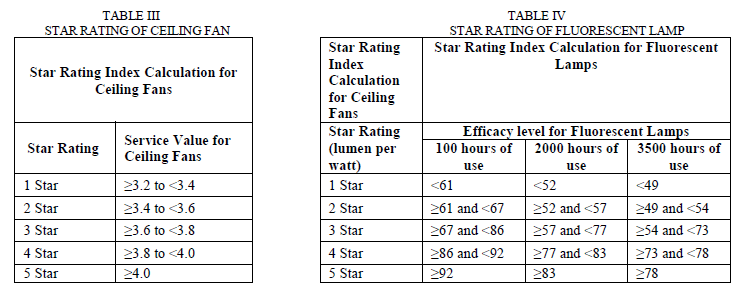 |
| It is evident that higher the star rating, higher the service value meaning the higher efficiency. It is recommended to install the 5 star rating ceiling fans replacing the existing fans. |
| 2) Fluorescent Lamp: The fluorescent lamp has two important technical quantitative factors: Power Consumption and Luminance. BEE came up with a concept of efficacy that is a ratio of lumens to power consumption. Table IV shows the efficacy level of fluorescent lamp against star rating for 100 hours of use, 2000 hours of use and 3500 hours of use. It is evident from the table that higher the star rating, higher the efficacy level meaning the higher efficiency. It is recommended to install the 5 star rating fluorescent lamps replacing the existing fluorescent lamps. |
| 3) Air Conditioner: The air conditioner has two important technical quantitative factors: Power Consumption and Cooling capacity. BEE came up with a concept of Energy Efficient Ratio (EER) value that is a ratio of cooling capacity to power consumption. The table V shows the EER value against the star rating. The higher the star rating, higher the EER value and higher is the efficiency for air conditioner. |
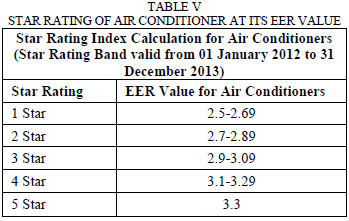 |
| Table VI shows the saving in power if all the existing conventional appliances are replaced by the 5-star rating appliances being 578 watt. Table VII shows the energy consumption with 5 star appliances per month being 376.07 kWh and cost per month being Rs. 2,256.42 and per year being Rs. 24820.62. |
 |
 |
 |
| Table VIII shows the saving in energy per year being 979.11 kWh and saving in cost per year being Rs. 5874.66. The fig 1 shows the bar chart comparing energy consumption between existing conventional and 5 Star rating appliances. The energy spent with 5 star appliances is 80.86% of the existing system. It shows the saving of 19.14% of existing energy spent. |
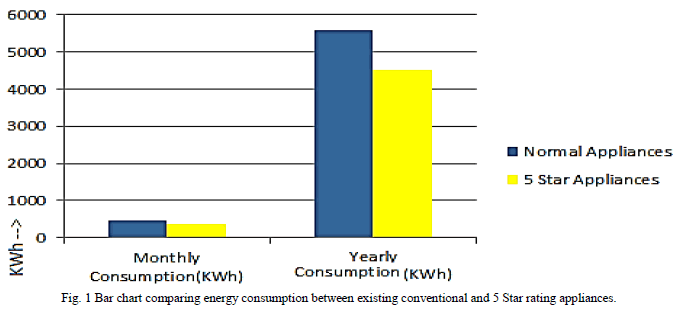 |
| B. Installation of Designed Modern Electronic System |
| The motivation of developing this micro-controller based system is to switch on/off the light, fan and air conditioner during the required period. That means the light and fan would be operational as and when any faculty member is present in his table, else these would be off. |
| 1) Ceiling Fan and Fluorescent Lamp: Each table and chair is fitted with a ceiling fan and a fluorescent light which will be powered on when the Faculty member is in table. When one will be away from the table the appliances will be switched off automatically. This will prevent the energy waste and conserve the energy. |
| The principle of designing the microcontroller is depicted bellow considering the light and fan. |
| • As and when a faculty member will occupy the chair, his presence will be detected by the sensor and communicated to the microcontroller. |
| • When he will be out of picture his absence will be again detected by the controller and switch off the corresponding light & fan. |
| To implement the interfacing circuit the following schematic diagram is shown in figure 2. |
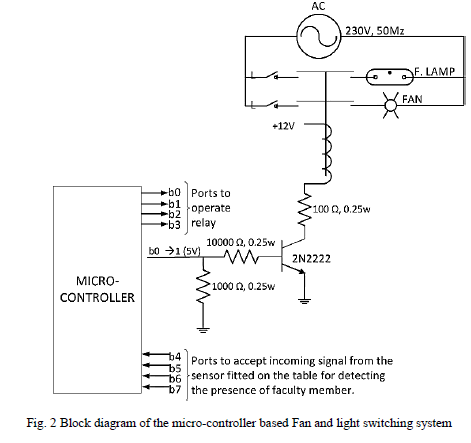 |
| The figure 2 shows that an 8 bit port of a microcontroller is used for the purpose. 4bits(b0 to b3) are used for operating the relays, configured as output bits and remaining 4 bits are configured as input bit to sense the presence of faculty member through sensor. Bit b0 is connected to a driver transistor 2N2222 (collector current, IC= 800mA) to which relay coil connected as shown. The single bit b0 has used to operate the fan and florescent lamp assigned to a faculty member. Similarly bits b1, b2, b3 are used for other faculty members with same kind of circuit. Bit b4 is used for sensing the presence / absence for the same faculty member. |
| Bit pairs [(b0, b4), (b1, b5), (b2, b6) & (b3, b7)] are used for faculty members 1 to 4 respectively. |
| In order to implement the system a program has been written with following algorithm, given below. |
| I. Configure the ports for the system: b0-b3 as output port and b4-b7 as input port. |
| II. Collect the data from b4 to b7 and checked any bit is logic 1 or not. |
| III. If any bit is logic 1, corresponding output bit is set to logic 1 to activate the relay coil through the driver circuit else keep all these circuit at logic 0 |
| IV. If any faculty member already entered leaves the faculty room the sensor will sense his absence and send the information as logic 0 through the corresponding input bit. CPU will turn off the corresponding output bit, deactivating the relay coil .These will switch the light and fan off. |
| V. Go to step (II). |
| It is found that an individual turn on switch when he/she need light and/or fan, but generally forgets to switch it off when leaves. The automatic switching on off fan and light has not been done to give added option to the faculty to choose the actual need of light and/or fan. Thus itâÃâ¬ÃŸll minimise superfluous power on of the appliances and minimize energy consumption. |
| It is assumed that a faculty member has 16 hours of class assignment per week and he attended the assignment ideally. If these appliances are automatically off during these 16 hours through the micro controller based system, the waste of energy would be prevented and the bill be lowered. In ideal condition the faculty room will not be empty, so the air conditioner will be running from morning to evening with hot and cold wind throughout the year excluding one month vacation. Table IX & X shows the consumption of power. It is assumed that a month is considered as 4.5 week. To calculate the power consumption, the assigned duty hours are excluded as shown in the equation (1) below. |
 |
| Power consumption/month/4nos of 5star ceiling fan(S) =P x (Q-R)/1000 kWh …………….. (1) |
| The table IX shows the power consumption for conventional system (465kWh), after applying 5 Star rating appliances (376 kWh) and microcontroller managed 5 Star rating appliances (354 kWh) and saving in energy per year being 1225.4 kWh and saving in cost per year being Rs. 7352.4/-. The fig 3 shows the bar chart comparing energy consumption among existing conventional system, 5 Star rating appliances and microcontroller managed 5 Star rating appliances . It shows the saving of 24% of existing energy spent. Cost of implementing the system will be paid back very soon. |
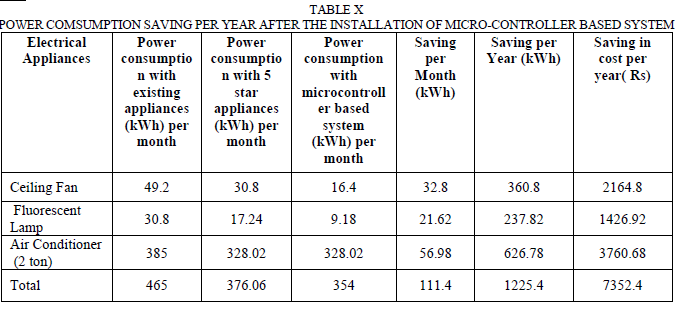 |
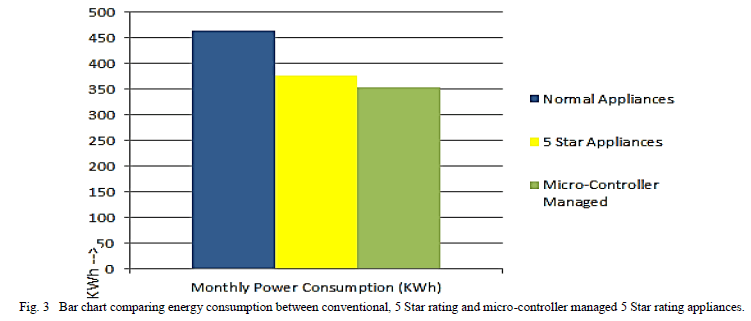 |
CONCLUSION
|
| The paper has studied the energy reduction in two ways- |
| • Recommendation of Energy Efficient appliances |
| • Implementation of microcontroller based system to reduce energy consumption. |
| In its first step, energy of 89.01 kWh per month has been reduced. |
| Applying the developed microcontroller based system, energy of 111.4 kWh has been saved per month. This shows that about 24 % energy is saved per month after applying these two recommended systems. Had these microcontroller based system been included the control of air conditioner, the percentage saving in energy could have shown better result. |
ACKNOWLEDGMENT
|
| The authors are really thankful to the Department of Electrical Engineering, Kalyani Government Engineering College, Kalyani, Nadia and The Department of Computer Science and Engineering, University of Kalyani, Kalyani, Nadia for extending the infrastructural facilities without which it was difficult to implement the system. |
References
|
- Energy Commission Malaysia, “Efficient Management of Electrical Energy Regulations,” ST, 2008.
- S. R. Bhawarkar and S. Y. Kamdi, “Electrical Energy Audit of a Electroplating Unit – A case study,” 2011 International Conference onRecent Advancement in Electrical, Electronics and Control Engineers, pp. 25-29, 2011.
- W. N. W. Muhamad, M. Y. M. Zain, N. Wahab, N. H. A. Aziz, and R. A. Kadir, “Energy Efficient Lighting Design for Building”, 2010International Conference on Intelligent Systems, Modelling and Simulation, pp. 282-286, 2010.
- H.E. Hua, L. Tian-yu, Z. Zhi-yong, and Z. Juan, “Energy Saving Potential of a Public Building in Jiangbei District of Chongqing,”International Conference on Management and Service Science, 2009.
- Noor M. Maricar,Md. N.Jamal Electrical Engineering Department University of Hail, „Industrial Energy Audit Web Application using DataMining Model. Conference
- K. S. K. Weranga, D. P. Chandima, Member, IEEE, and S. P. Kumarawadu, Member,IEEE„ Smart Metering for Next Generation EnergyEfficiency & Conservation ,IEEE Conference.IEEE PES ISGT ASIA 2012 1569564125.
- L. Dumitru,Y.H.Said,S.PLOIX Increasing Energy Efficiency in Data Centres using Energy Management 2011 IEEE/ACM InternationalConference on Green Computing and Communications, IEEE Computer Society.
- Wang, C. Huang, and W. Cao, “Energy Audit of Building: A case study of a Commercial Building in Shanghai,” Power and EnergyEngineering Conference (APPEEC), 1-4, 2010.IEEE Standard 739-1995, IEEE Standard Practice for Energy Management in Industrial andCommercial Facilities, 1995.
- A. Thumann and W. J. Younger, “Handbook of Energy Audits (7thEd.),” Fairmont Press, pp. 1-12, 2008.
- J. Randolph and G. M. Masters, “Energy for Sustainability: Technology, Planning, Policy,” pp. 165-212, 2008.
- M.U.Khalid, M.Gul ,M.M.Aman, A.Hashmi ”Energy Conservation through Lighting Audit-a case study 2012 IEEE International Conferenceon Power and Energy(PECon),2-5 December 2012 Malaysia.
|